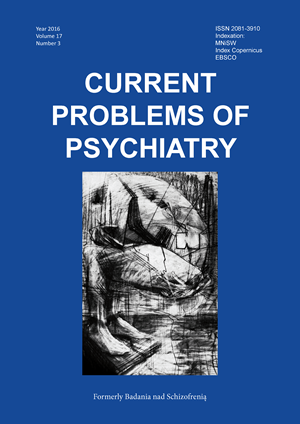Modern faces of hysteria, or some of the dissociative disorders
DOI:
https://doi.org/10.1515/cpp-2016-0022Keywords:
hysteria, dissociative disorders, amnesia, fugue, trance, possessionAbstract
The concept of "hysteria" comes from the Greek word "hystera" (uterus) and dates back to the time of Hippocrates, at least. Modern classifications differ regarding the area encompassed by the concepts of dissociation and conversion differ. Mental health profes-sionals in the United States (DSM-5) use a standard classification of mental disorders codifying dissociative disorders as a distinct class of disorders, but subsumes conversion disorders under "somatoform disorders". The history of hysteria is as long as the history of mankind. Apparently, both the essence and mechanisms of dissociative disorders remain unchanged despite the fact that many years have passed. According to Owczarek et al., dissociative symptoms are caused by the malfunctioning of defence mechanisms and anxiety. This article provides an overview of the available literature on the etiology and pathogenesis of dissociative disorders as well as disor-ders such as amnesia, dissociative fugue, trance and possession.
References
1. Araszkiewicz A. Zaburzenia dysocjacyjne. W: Pużyński S., Rybakowski J., Wciórka J.(red.). Psychiatria. Tom2. Wyd.2., Wrocław; Elsevier Urban & Partner: 2011, 453-466.
2. Maldonaldo J.R., Spiegel D. Zaburzenia dysocjacyjne. W: Hales R.E., Yudofsky S.C., Gabbard G.O. (red.) Psychiatria. Tom 3. Warszawa; MediPage: 2012, 1-45.
3. Spiegel D., Lewis-Fernandez R., Lanius R., Vermetten E., Simeon D., Friedman M. Dissociative disorders in DSM-5. Annu Rev Clin Psychol, 2013; 9: 299-326.
4. Dąbkowska M. Trudności diagnostyczne u dzieci z zaburzeniami konwersyjnymi. Pediatr Pol, 2008; 83(3): 281-285.
5. Aleksandrowicz J. W. Zaburzenia nerwicowe, zaburzenia osobowości i zachowania dorosłych (według ICD-10). Wyd.2. Kraków; Wydawnictwo Uniwersytetu Jagiellońskiego: 1998, s. 79-87.
6. Załuska M., Żurko R., Kuroń M., Jakiel G., Dudel A. Psychiatr Pol, 2011; XLV (4): 599-609.
7. Mamarde A., Navkhare P., Singam A., Kanoje A. Recurrent dissociative fugue. Indian J Psychol Med, 2013; 35 (4): 400-401.
8. Ural C., Belli H., Akbudak M., Tabo A. Childhood Traumatic Experiences, Dissociative Symptoms, and Dissociative Disorder Comorbidity Among Patients With Panic Disorder: A Preliminary Study. J Trauma Dissociation, 2015; 16(4): 463-475.
9. Ishida M., Onishi H., Toyama H., Tsutsumi C., Endo C., Tanahashi I., Takahashi T., Uchitomi Y. Missing memories of death: Dissociative amnesia in the bereaved the day after a cancer death. Palliat Support Care, 2015, 13(6): 1787-1790.
10. Somer E., Ross C., Kirshberg R., Bakri R.S., Ismail S. Dissociative disorders and possession experiences in Israel: a comparison of opiate use disorder patients, Arab women subjected to domestic violence, and a nonclinical group. Transcult Psychiatry, 2015; 52(1): 58-73.
11. Sharma P., Guirguis M., Nelson J., McMahon T. A case of dissociative amnesia with dissociative fugue and treatment with psychotherapy. Prim Care Companion J Clin Psychiatry, 2015; 17(3): 1523-5998.
12. Raval C.M., Upadhyaya S., Panchal1 B.N. Dissociative fugue: Recurrent episodes in a young adult. Ind Psychiatry J., 2015; 24(1): 88-90.
13. Thomas-Antérion C., Dubas F., Decousus M., Jeanguillaume C. and Guedj E. Clinical characteristics and brain PET findings in 3 cases of dissociative amnesia: disproportionate retrograde deficit and posterior middle temporal gyrus hypometabolism. Neurophysiol Clin., 2014; 44(4): 355-362.
14. Jha M. i Sharma V. Dissociative Fugue Disorder: Identification and Psychological Intervention. Psychol Stud, 2015; 60 (1): 17 -24.
15. Igwe M.N. Dissociative fugue symptoms in a 28-year-old male Nigerian medical student: a case report. J Med Case Rep., 2013; 7: 143.
16. Tomalski R. Aleksytymia i dysocjacja. Psychoterapia, 2008, 2(145): 35-43.
17. Owczarek K, Rola wskaźników lęku w występowaniu psychogennych napadów rzekomopadaczkowych I innych zaburzeń dysocjacyjnych. Epileptologia, 2007; 15: 193-201.
18. MacPhee E. The Dissociative Disorders in Medical Settings. Curr Psych Rep., 2013; 15(10): 398.
19. Okano K. Clinical Handling of Patients with Dissociative Disorders. Seishin shinkeigaku zasshi, 2015; 117(6): 399-412.
20. DSM-5.
21. Kazimierz Franczak: Koncepcje interpretacyjne i badania doświadczenia religijnego we włoskiej psychologii religii. VERBINUM 2007.
22. Zeig J.K. 1985 The clinical use of amnesia: Ericksonian methods. In J.K. Zeig(Ed), Ericksonian psychotherapy, Volume I: Structures New York: Brunner/Mazel.
23. H.Welcz. Zjawiska transowe w tradycyjnej wiejskiej polskiej kulturze tanecznej. Current Problems of Psychiatry 2011; 12(3): 330-332.
24. Manie taneczne. Między kulturą a medycyną. Psychiatria Polska 2011, tom XLV, numer 2, str. 277-287.
25. Jacek Dębiec Opętanie. Próba psychopatologicznego ujęcia problemu. Wydawnictwo UJ, Wyd. I, Kraków 2000.
26. M.Z. Stepulak Wybrane zagadnienia z psychologii pastoralnej. Wyższe seminarium duchowne Siedlce-Opole 2007.
27. Opętanie jako kategoria diagnostyczna w klasyfikacji ICD-10 i DSM-IV Aleksander Beszłej, Magdalena Grzesiak Katedra i Klinika Psychiatrii AM we Wrocławiu.
28. Wciórka J. red. Kryteria diagnostyczne według DSM-IV-TR. Warszawa: Elsevier; 2008.
29. List do redakcji. Wokół opętania. Psychiatria Polska 2016; 50(1) 289-292.
30. Stephenson C. The epistemological significance of possession entering the DSM. Hist. Psychiatry 2015; 26(3): 251–269.
31. Opętanie i egzorcyzm w świetle badań antropologicznych i neurologicznych. Studia Religiologica 47 (2) 2014, s. 105–123.
32. Elżbieta Trypka Opętanie czy psychoza? - opis przypadku. Katedra i Klinika Psychiatrii AM we Wrocławiu.
33. Pomiędzy wiarą a nauką: zniewolenie duszy czy zaburzenia dysocjacyjne? Prezentacja przypadku Psychiatria Polska 2012, tom XLVI, numer 2 str. 305-312.
34. Pokonać szatana. Egzorcysta czy psychiatra? Wydawnictwo JUT 2013 Szczebrzeszyn, tylna strona okładki.
35. Etienne Trillat Historia histerii. Wrocław Warszawa Kraków Zakład Narodowy imienia Ossolińskich Wydawnictwo 1993.
Downloads
Published
Issue
Section
License
Copyright (c) 2016 Authors

This work is licensed under a Creative Commons Attribution-NonCommercial-NoDerivatives 3.0 Unported License.


